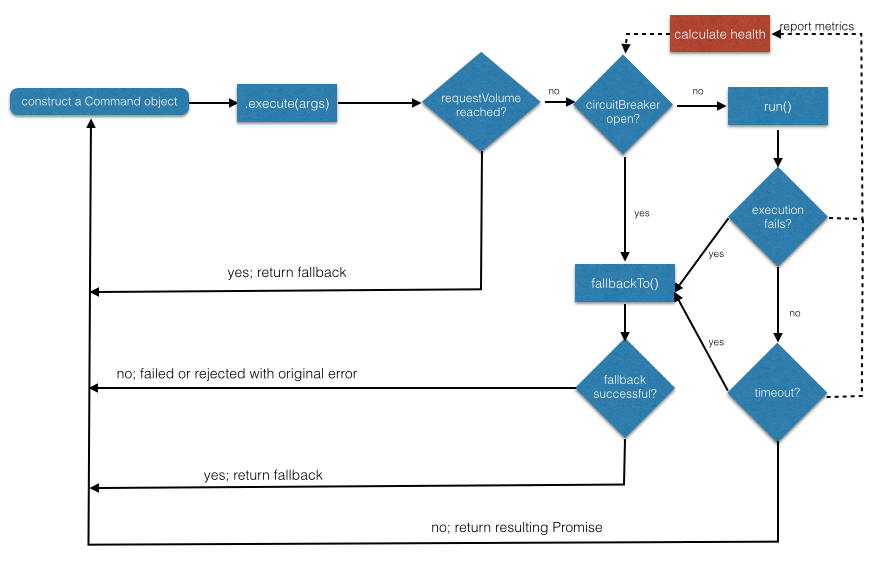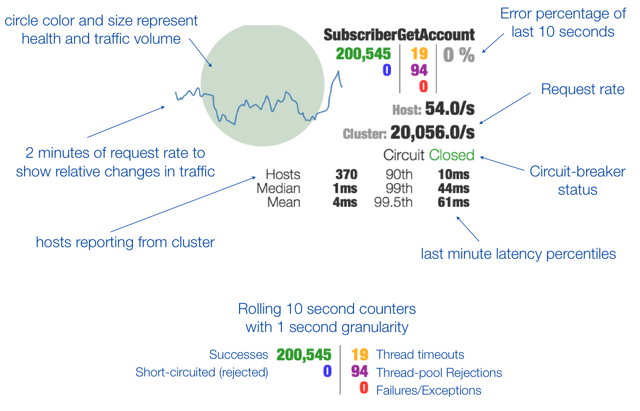hystrixjs
v0.2.0
Published
resilience module for NodeJS applications
Downloads
10,505
Readme
HystrixJS - resilience library for NodeJs applications
This library is inspired by the by the the Netflix Hystrix module for Java applications, which "is a latency and fault tolerance library designed to isolate points of access to remote systems, services and 3rd party libraries, stop cascading failure and enable resilience in complex distributed systems where failure is inevitable".
Including it in your project
Install the hystrixjs via npm.
npm --save hystrixjsRxJs
RxJs is required for the optional monitoring event stream.
RxJs 5 is an peer dependency and will
generate an NPM warning if missing. RxJs 3 and 4
are supported as peers but are deprecated and not listed in the package.json
of this project. If you have included rx@>=3.0.0 or are not using the
monitoring event stream you can ignore NPM's peer dependency warning.
For more details see Monitoring below.
How does it work?
Basically it tries to achieve the same goals as the original Netflix implementation:
- protect applications from failures from dependencies accessed over the network or 3rd party clients
- stop cascading failures and prevent ripple effect
- fail fast and rapidly recover
- provide a sensible fallback and degrade gracefully if possible
- provide near realtime monitoring
Since this library targets nodejs application, it is by far not as complex as the java implementation (remember... just one thread... no concurrency, at least most of the time...). So how does it accomplish the goals outlined above:
- wraps all promise-based calls to external systems (or "dependencies") in a "Command"
- times out calls that take longer, than the configured threshold.
- measures successes, failures (exceptions thrown by client), timeouts, and short circuits
- measures execution times
- trips a circuit-breaker to stop all requests to a particular service for a period of time, if the error percentage for this service passes a configured threshold
- performs fallback logic, when the execution fails, times out or is short-circuits
- provides a SSE of metrics, which can be visualised in Hystrix Dashboard for near real-time monitoring
Following diagram shows what happens when a function call is wrapped in a Command

The Command is constructed with the help of the CommandsFactory. It expects a unique key and a "run" function, which will be called, when the command is executed. Note: the function must return a Promise. The returned object provides an execute() method, which will call the specified "run" function with the passed arguments. Within the execute() method it will check if the overall request volume threshold has been reached. If the command is already executing a certain amount of requests, the request will be rejected immediately to avoid overloading the downstream service and the fallback will be returned instead. If the threshold is not reached it will check if the circuit breaker is open (or "tripped") and if it is, it will forward the execution to the fallback function with the Error("OpenCircuitError"). If the circuit is closed, the command will call the provided "run" function. If the function times out or fails, the execution will be forwarded to the fallback method with the Error("CommandTimeOut") or the execution error respectively. Per default the fallback function rejects the promise with the passed error. It could however implement a logic to provide a generic response, which does not depend on network calls. If the "run" function succeeds, the command will return a Promise resolving with the response, after it performs some metrics logging.
Calculating Circuit Breaker Health
The circuit breaker follows the same logic as the one in the original Hystrix Module. In short following steps are performed to calculate the health:
- if the volume across the circuit does not exceed the configured volume threshold, the will just execute the run function without checking (the metrics will still be logged and considered for future checks). If the volume exceeds the threshold, the circuit will check the health first
- if the error percentage exceeds the configured threshold, the circuit transitions from Closed to Opened state and all requests will be rejected with the Open Circuit Error
- after configured time the circuit breaker will allow a single request to check if the services has recovered. If this request succeeds, the circuit is closed and the counters are reseted.
Creating a command
All external communication points should be wrapped within a command. The command factory is the entry point to get the existing or generate a new command.
var CommandsFactory = require('hystrixjs').commandFactory;
var serviceCommand = CommandsFactory.getOrCreate("Service on port :" + service.port + ":" + port)
.circuitBreakerErrorThresholdPercentage(service.errorThreshold)
.timeout(service.timeout)
.run(makeRequest)
.circuitBreakerRequestVolumeThreshold(service.concurrency)
.circuitBreakerSleepWindowInMilliseconds(service.timeout)
.statisticalWindowLength(10000)
.statisticalWindowNumberOfBuckets(10)
.errorHandler(isErrorHandler)
.build();
Each generated command is cached based on its key supplied as the first parameter. The "getOrCreate()" method returns a "CommandBuilder" object, which provides methods for configuration of:
- circuitBreakerSleepWindowInMilliseconds - how long the circuit breaker should stay opened, before allowing a single request to test the health of the service
- errorHandler - function to validate if the error response from the service is an actual error. If this function returns an error object (default implementation), this request call will be marked as failure, which will influence the error percentage. If it returns null or false, the call will not be marked as failure. An example could be a 404 error, if the customer is not found.
- timeout for request
- circuitBreakerRequestVolumeThreshold - minimum number of requests in a rolling window that needs to be exceeded, before the circuit breaker will bother at all to calculate the health
- circuitBreakerForceOpened - force this circuit breaker to be always opened
- circuitBreakerForceClosed - force this circuit breaker to be always closed
- circuitBreakerErrorThresholdPercentage - error percentage threshold to trip the circuit
- statisticalWindowLength - length of the window to keep track of execution counts metrics (success, failure)
- statisticalWindowNumberOfBuckets - number of buckets within the statistical window
- percentileWindowNumberOfBuckets - number of buckets within the percentile window
- percentileWindowLength - length of the window to keep track of execution times
- requestVolumeRejectionThreshold - maximum number of concurrent requests, which can be executed. Defaults to 0, i.e. no limitation
- fallbackTo - function, which will be executed if the request fails. The function will be called with the error as the 1st argument and an array of the original args as the 2nd argument
All of these options have defaults and does not have to be configured. See HystrixConfig for details. These can be overridden on app startup.
Executing a command
To execute a command just call the "execute" method and pass the parameters:
var promise = serviceCommand.execute(arguments)The arguments will be passed into the run function and the result will be a promise. If the run function fails, the arguments will passed to the fallback function (in an array) as the 2nd argument.
How to test?
Testing could be tricky, especially because the library introduces state, which could interfere between the single unit tests. In order to avoid this kind of problems the library provides access to the factories producing metrics, circuits and commands. These can be used to reset the state before each test:
var commandFactory = require('hystrixjs').commandFactory;
var metricsFactory = require('hystrixjs').metricsFactory;
var circuitFactory = require('hystrixjs').circuitFactory;
metricsFactory.resetCache();
circuitFactory.resetCache();
commandFactory.resetCache();The same problems occur during integration tests, only in this case there is no direct access to the artifacts. There could be two different strategies to solve this problem:
- restarting the service under test before each test, which can significantly increase the execution time
- adding and calling an endpoint to reset the metrics before each test
Another question is, how to actually test, that the library is used correctly. Specifically, it should be possible to test, that if the circuit is open, the service under test is not calling the 3rd party services and the command returns a correct error message (e.g. 503 Service is unavailable). Now the biggest problem is to generate a load on the service to make the command to actually trip the circuit. Remember circuitBreakerRequestVolumeThreshold, the circuit breaker won't do anything, if the load on the 3rd party library is not high enough. To tackle this kind of problem one could:
- generate the load on the service within the test, which is not trivial, since it is not quite easy to do it in node (one thread, no concurrency). One could spawn a child process to hammer the service from the integration test, but it seemed to be very clumsy and flakey as well
- provide configuration hooks to influence the library, which can be overridden based on environment
HystrixConfig provides two configuration options with the following defaults:
"hystrix.circuit.volumeThreshold.forceOverride": false,
"hystrix.circuit.volumeThreshold.override": 10,Depending on the environment the service is being started in, these options can be overridden:
var hystrixConfig = require('hystrixjs').hystrixConfig;
if (localEnv) {
hystrixConfig.init({
"hystrix.circuit.volumeThreshold.forceOverride": true,
"hystrix.circuit.volumeThreshold.override": 0
});
}This will make the library to always check the circuit breaker before executing a request. So now the circuit can be tripped by a deliberately false request, which would record a failure and bump the error percentage to 100%. The subsequent request, which should normally return a 200 response, should fail with 503 response:
makeRequest('returning-http-500').fail(function (json) {
expect(json).toEqual({
errors: [{
message: 'There was an unexpected error.'
}]
});
makeRequest('returning-success-200').fail(function (json) {
expect(json).toEqual({
errors: [{
message: 'Service unavailable.'
}]
});
}).then(failTest(done));
}).then(failTest(done));Monitoring
The library provides a module HystrixSSEStream to export gathered metrics as a server side events stream. This stream can be used with Hystrix Dashboard to visualise the current state of the service, or its external communication points to be more precise:

In order to use this the service must include RxJs, either from
rx@>=3.0.0 or
rxjs@^5.0.0, and
expose a monitoring end point, which writes the SSE data into response:
var hystrixSSEStream = require('hystrixjs').hystrixSSEStream;
function hystrixStreamResponse(request, response) {
response.append('Content-Type', 'text/event-stream;charset=UTF-8');
response.append('Cache-Control', 'no-cache, no-store, max-age=0, must-revalidate');
response.append('Pragma', 'no-cache');
return hystrixSSEStream.toObservable().subscribe(
function onNext(sseData) {
response.write('data: ' + sseData + '\n\n');
},
function onError(error) {
console.log(error);
},
function onComplete() {
return response.end();
}
);
};Failure to include either rx or rxjs will throw an Error at load
time. If both rx and rxjs are included, rxjs will be used.
Promises
HystrixJS can work with any ES6 compatible promise implementation. By default all promises returned will be built-in Node.js promises. To configure another library, specify the promise implementation when initializing the HystrixConfig module. E.g. for Bluebird:
var Promise = require('bluebird');
// Or Q
// var Promise = require('q').Promise;
var hystrixConfig = require('hystrixjs').hystrixConfig;
hystrixConfig.init({
// any other hystrix options...
"hystrix.promise.implementation": Promise
});
